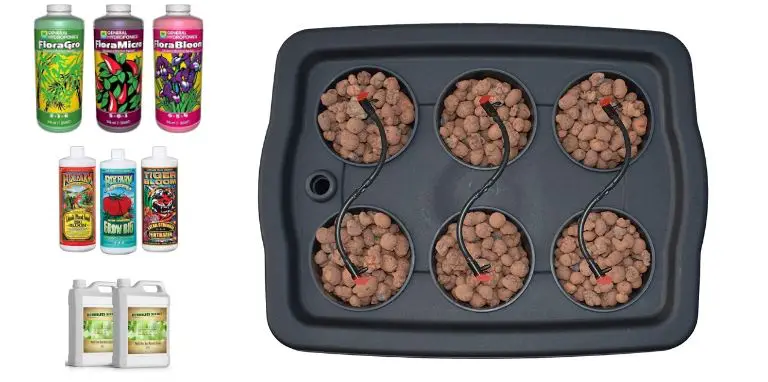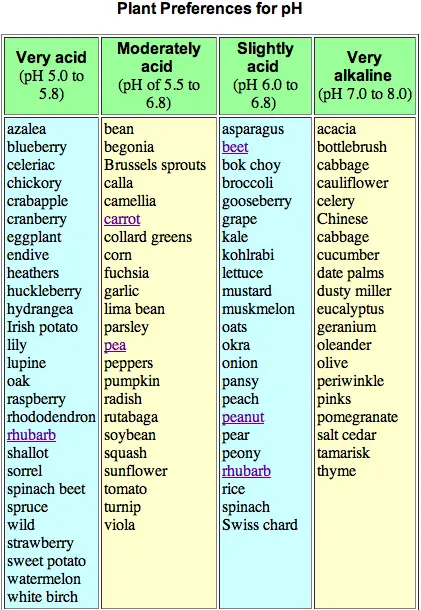Deep Water Culture (DWC) is a form of hydroponics where plant roots are completely submerged in a highly oxygenated, sanitary, nutrient solution reservoir.
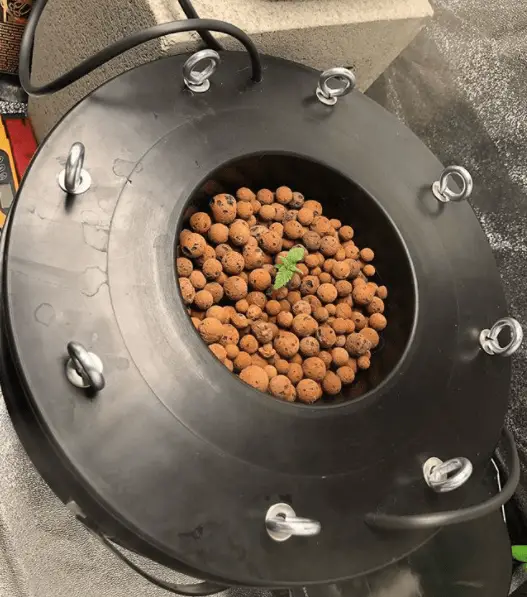
Table of Contents:
- Deep Water Culture Nutrient Solutions 101
- Electrical Conductivity
- pH Monitoring
- Deep Water Culture Media
These systems are one of the many hydroponic techniques that utilize an air pump to circulate nutrient solution mixture to plant roots.
An airline is connected to the pump and the plant roots are usually nested in a netted pot.
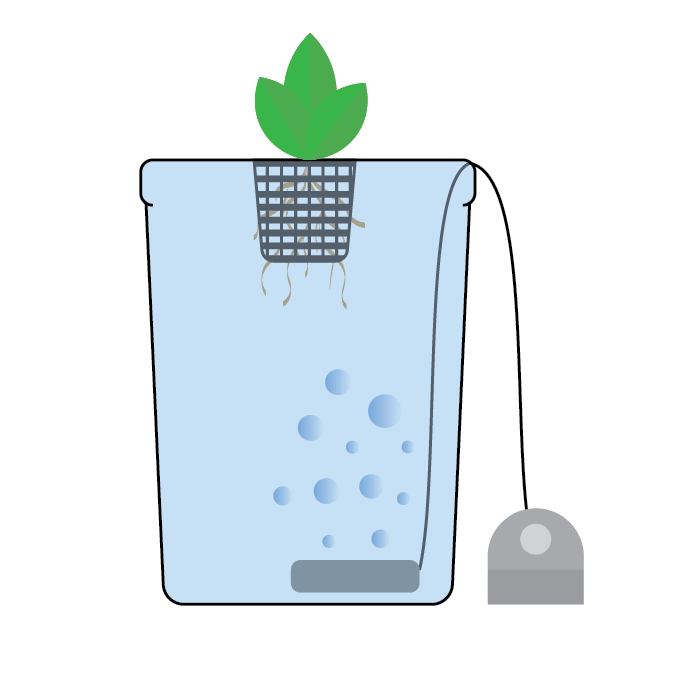
Hydroponic systems can vary drastically:
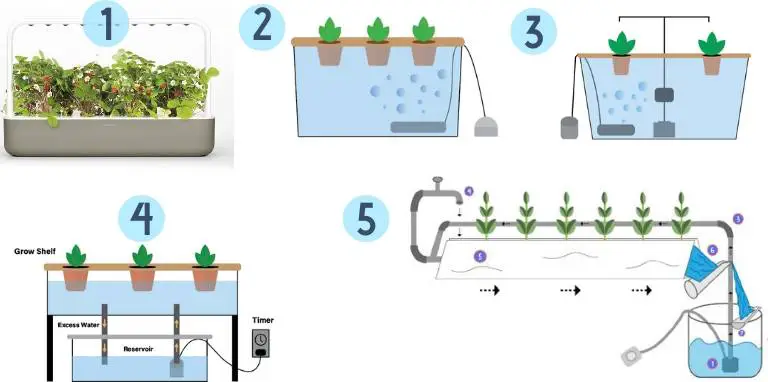
| Technique | Difficulty | Average Price | Overall Score |
|---|---|---|---|
| 1. Aeroponics | 2/10 | $$ | 98% |
| 2. Deep Water Culture | 4/10 | $ | 93% |
| 3. Drip | 6/10 | $$$ | 91% |
| 4. Ebb & Flow | 8/10 | $$ | 93% |
| 5. Nutrient Film | 8/10 | $$$ | 90% |
- Aeroponics utilizes either a sprayer or fogger to provide suspended plant roots a constant supply of tiny nutrient solution water droplets that range from 5 – 100 microns in average size.
- Deep Water Culture – the topic of this article – utilizes an air pump and an airline to distribute nutrient solution to submerged plant roots.
- Drip Hydroponic systems utilize an airline and an air pump to distribute nutrient solution to plant roots from above.
- Ebb and Flow systems use an air pump to direct a consistent flow of nutrient solution to plant roots.
- Nutrient Film Technique uses an air pump and a solution tank to recycle nutrient solution to plant roots continuously.
For a detailed look at these systems, check out our comprehensive guide to the best hydroponic systems.
Because hydroponic systems differ so drastically in how they deliver and dispense nutrients to plant roots, it makes sense that nutrient solution requirements also differ between systems.
Now, it’s worth mentioning that these differences aren’t massive – in fact, there is a lot of overlap, after all, hydroponics is simply growing plants with a nutrient solution as opposed to soil – but finding the optimal nutrient solution for your hydroponic system should be a top priority.
So, with that being said, let’s take a detailed look at the best nutrient solutions for Deep Water Culture systems. We’ll also touch on growing media, electrical conductivity rating, and pH measurements.
Deep Water Culture Nutrient Solutions
In order to properly use hydroponic nutrient solutions, you need to understand three basic terms.
- NPK Ratio: NPK stands for Nitrogen (N), Phosphorus (P), and Potassium (K) – the three most consequential macronutrients for optimal plant growth – you will see the NPK ratio listed on every bottle of hydroponic nutrient solution that you come across. So, a nutrient solution that is labeled with an NPK ratio of 4-3-6, would contain 4% Nitrogen, 3% Phosphorus, and 6% Potassium.
- Meso-nutrients: Are secondary macro-nutrients like Magnesium, Calcium, and Sulfur.
- Micronutrients: Iron, Boron, Chloride, Copper, Manganese, Molybdenum and Zinc are all vital micronutrients that plants need.
At this point in time, there is really no need to create your own nutrient solution mixture. There are dozens of high-quality pre-made mixtures that are designed for very specific plant needs.
At a glance, the following table lists the best nutrient solutions for Deep Water Culture by NPK Ratio(s) and overall score:
| Nutrients | NPK Ratio(s) | Score |
|---|---|---|
| 1. General Hydroponics Flora Grow Series | 2-1-6, 5-0-1, 0-5-4 | 98% |
| 2. Humboldts Secret Base A & B Bundle | 1-4-2, 4-0-1 | 98% |
| 3. General Hydoponics MaxiGro | 10-5-14 | 96% |
| 4. Aerogarden Liquid Plant Food | 4-3-6 | 92% |
| 5. Fox Farm Trio Formula | 6-4-4, 0-0.5-0.7, 2-8-4 | 90% |
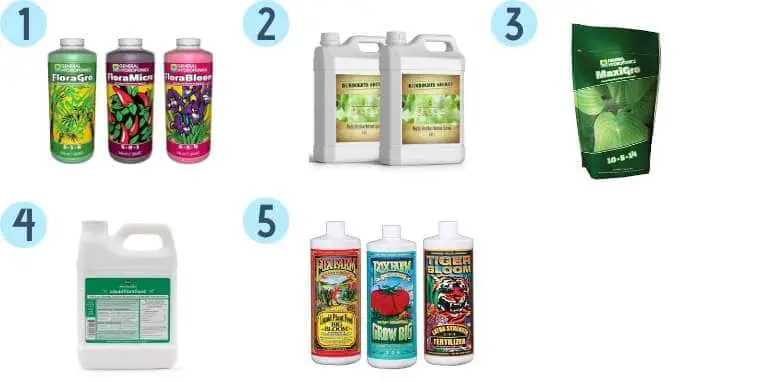
If you’re a beginner – especially if you’re using a pre-built DWC system, I recommend starting with a combo nutrient solution set.
Combo solutions – like the Flora Grow Series and the Fox Farm Trio Formula – make nutrient solution upkeep really easy.
How so?
Let’s use the Flora Grow Series as an example. Their three liquid solutions are labeled for the three growth stages of plant development:
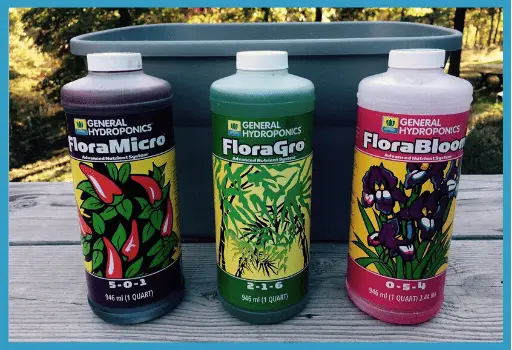
The FloraGro solution is ideal for the vegetative growth stage. This is where plant roots need higher Nitrogen levels, medium Phosphorous levels, and high Potassium levels.
The FloraBloom solution is ideal for the blooming growth stage. This is a period of time where plant roots need medium amounts of Nitrogen levels, high Phosphorous levels, and medium Potassium levels.
The FloraMicro solution targets the flowering stages of growth. During this period, plants need low Nitrogen levels, medium Phosphorous levels, and high Potassium levels.
With three separate solution mixtures, you have a higher level of agency over your plant’s nutrient intake at various stages of life.
Electrical Conductivity (EC) Meters
EC meters are commonly used to assess the electrical conductance value – the level of fertilizer concentration or salt concentration – within a given nutrient solution.
Contrary to popular belief, you do not need an EC meter – especially if you’re using a pre-made, commercial nutrient solution – but it can be a helpful tool if you’re experimenting with your own nutrient solution or if you feel like you may be adding nutrient solution too quickly to your reservoir or if you just want more insight and data regarding the conditions of your growing reservoir.
EC levels within a deep water culture system should be between 1.2 and 2.0.
Bright Agrotech has a great, beginner-friendly guide to EC monitoring for hydroponics.
pH Monitoring
Monitoring your system’s pH levels – the measurement of acidity within your growing reservoir – can be a bit more tricky than EC measurements.
pH monitors need to be properly calibrated and carefully used.
I’ve used numerous pH monitors over the years and if I’ve learned anything, it’s that they’re not all equal!
Some meters are just straight-up horrible: they give inaccurate or inconsistent measurements, they become quickly uncalibrated, and some require maintenance.
It’s for this reason that I recommend beginners start out with a pH control kit.
Instead of using a pH meter, these kits use a pH up, pH down solution along with a test indicator and vial.
You should follow the instructions carefully, but in essence, if your nutrient solution’s pH is too high (basic) you apply the pH down calibration solution to your reservoir; if it’s too low (acidic) you should use the pH up calibration solution.
Every plant has its own specific pH range, although herbs, vegetables, and succulents overlap quite a bit.
Most of the plants that you will grow within a Deep Water Culture system should have a pH between 5.0 – 6.8.
I always refer to the Farmer’s Almanac for specific pH levels.
Deep Water Culture Media
Choosing the right media is as important as monitoring nutrient solution pH and EC levels.
Why?
In hydroponic systems, media is used not only to anchor plant roots in place but also to provide plant roots with plenty of aeration and moisture.
Deep Water Culture systems are unique in that they are designed to submerge plant roots in a reservoir of constantly flowing nutrient solution.
Therefore, the optimal Deep Water Culture media should be:
- Porous and water retentive.
- Heavy enough to provide support for growing plants under conditions of circulating nutrient solution but no so heavy as to damage the roots.
- Comprised of little to no nutrients; you don’t want your system’s media to alter your nutrient reservoirs pH or EC levels.
The following table list the best media for Deep Water Culture:
| Media | Price | Score |
|---|---|---|
| 1. Clay Pebbles | $$ | 10/10 |
| 2. Growstones | $$$ | 9/10 |
| 3. Perlite | $$ | 7/10 |
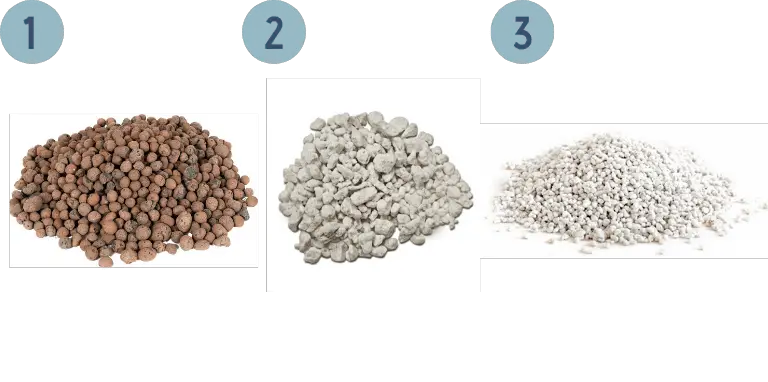
Clay pebbles are the most commonly used Deep Water Culture growing media as they are relatively inexpensive, very porous, reusable, and pH neutral.
Growstones are a bit more niche as they are expensive but make no doubt about it, they get the job done! They are heavier than both perlite and clay pebbles but not heavy enough to damage plant roots.
Perlite is another relatively inexpensive grow media that provides plant roots with ample oxygen, while still retaining moisture fairly well. It’s also made from volcanic glass, which is pretty cool!

